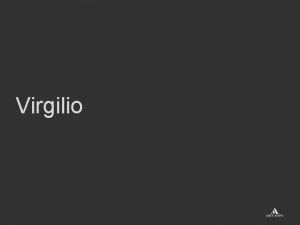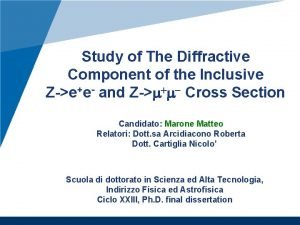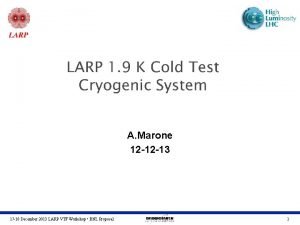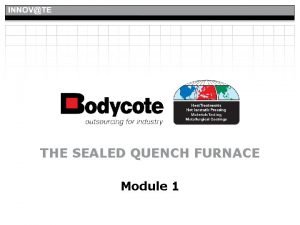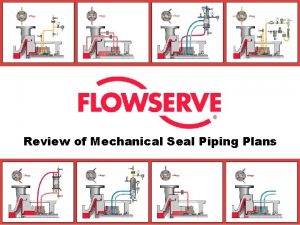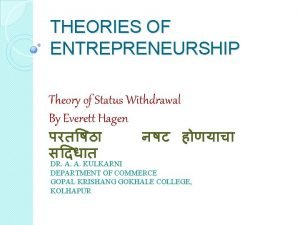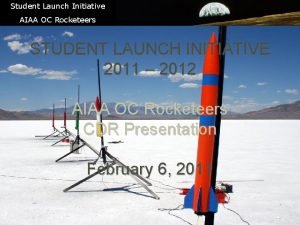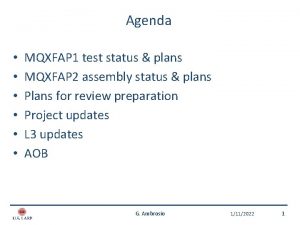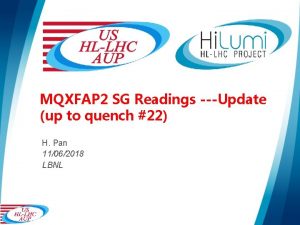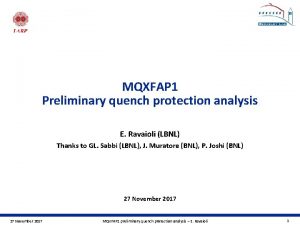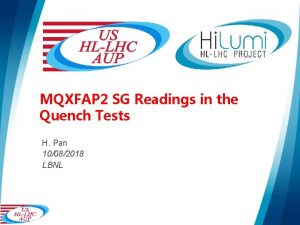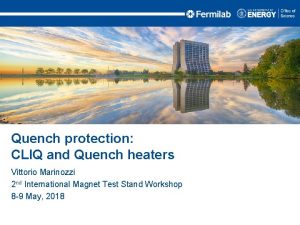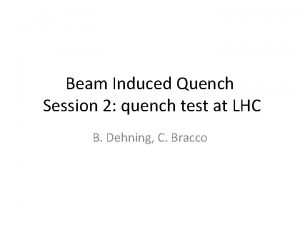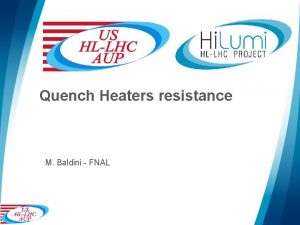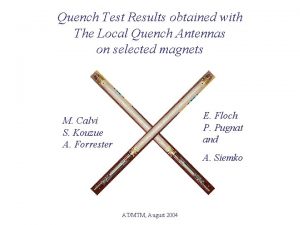MQXFAP 1 Quench Recovery A Marone 12417 Quench












- Slides: 12

MQXFAP 1 Quench Recovery A. Marone 12/4/17

Quench Summary Quench I (A) Energy into coil (MJ) Helium mass flow @ 2 seconds after rupture (g/s) 2 15440 2. 96 1750 3 15916 3. 20 2150

Quench 2 Graph

Quench 3 Graphs

Short Term Solutions Proposed Relief Stack • Redesign relief stack to protect burst disc. o Increase to 3” IPS. ( from 2” IPS) o (1) Cash C-776 ( 2”) relief valve 25 psig Set point • Capacity 1380 g/s @ 30 psig. o (2) Magnetrol 2” fast acting solenoid valves. • Capacity 1400 g/s @ 30 psig. o Total relieving capacity 4180 g/s @30 psig ( 5115 g/s @ 40 psig) o Time to complete ( 3 weeks)

Short Term Solutions Cold Storage • Use Test Dewar 3# ( about 6 feet away) as cold helium storage. o Connect in series with test dewar with a VJ transfer line. o Would add 2. 2 cubic meters of cold helium storage. o This would allow for about 30 KG of additional cold helium storage (@ 30 psig and 9 K) • Liquid Helium contained in test dewar about 87 kg. o Most plumbing already set up. o Need transfer line between dewars and additional Transfer line to keep some liquid in the dewar. o Estimate 5 -6 weeks to complete.

Cold Storage

Long Term Solutions Increase Recovery Capability • Increase piping size to 6” to quench valve, then 10” out to recovery tanks. • Move 30, 000 gal. tank closer to test facility. • Possibly add another existing tank (on site)to lower final tank pressure.

Summary • Peer Reviews are ongoing (R. Than- BNL, R. Rabehl. FNAL). BNL Cryo. Safety Committee review also needed. • Now (3 -4 weeks) o Increase relief capacity to 4180 g/s @ 30 psig to avoid burst disk rupture. o Increase fast logger window to capture entire event. • Add second dewar as cold storage (6 weeks). o Need transfer line between dewars. o Can significantly reduce helium loss. o Cost 10 K-20 K • Long term o Collect data on quenches as they occur. o Upgrade recovery line to 10” • Will reduce pressure buildup in test dewar. o Move 30, 000 gal tank closer to facility.

Backup Slides

Quench #2 (11 -13 -2017) • • Current at quench; 15440 Amps (3. 93 MJ) Energy deposited into coil; 2. 96 MJ ( 25% extraction) Time from Quench to Burst disc rupture; approx. 13 s. At time of burst disc rupture; rating 40 psig. o Estimated flow into quench tanks 500 g/s ( from gage pressure readings). o Anderson –Greenwood relief valve set at 30 psig never relieved. • Calculated mass flow 2 seconds after rupture o Through burst disk ( 1400 g/s) o Through quench system ( approx. 350 g/s)

Quench #3 (11 -15 -2017) • • Current at quench; 15916 Amps (4. 18 MJ) Energy deposited into coil; 3. 20 MJ ( 23% extraction) Time from Quench to Burst disc rupture; approx. 16 s. At time of burst disc rupture; rating 40 psig. o Estimated flow into quench tanks 550 g/s ( from gage pressure readings). o Anderson –Greenwood relief valve, set pressure reduced to 10 psig (valve actively relieving at time of rupture). Calculated flow 390 g/s. • Calculated mass flow 2 seconds after rupture o Through burst disk ( 1650 g/s) o Through quench system ( approx. 500 g/s) • 4 seconds after rupture flow rates match that of quench #2 , 2 seconds after rupture.
 Virgilio poeta biografia
Virgilio poeta biografia Matteo marone
Matteo marone Marone 12
Marone 12 Scuola media statale virgilio marone
Scuola media statale virgilio marone Lhc quench
Lhc quench Sealed quench furnace process
Sealed quench furnace process Many waters cannot quench love
Many waters cannot quench love Seal flush plan 11
Seal flush plan 11 Service recovery refers to
Service recovery refers to The status withdrawal theory was proposed by
The status withdrawal theory was proposed by Strabisumus
Strabisumus Disaster recovery plan presentation
Disaster recovery plan presentation Ardu recovery center
Ardu recovery center
